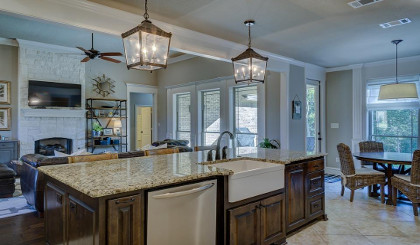A fireclay sink has a timeless, and appealing appearance that can be a sound option for homeowners that are looking for durability and a vintage theme. Fireclay is a fine choice of sink for some kitchens, but not every kitchen.
These sinks have no lips protruding over the counter. This is great for
wiping residue on the counter smoothly into the basin.
A fireclay sink is a type of ceramic sink. These sinks are not carved; they are molded at extreme temperatures. The process of molding starts when clay is formed into the desired size and shape of the sink, which then dries under a mild level of heat for up to 2 days.
Once the clay is dry, porcelain enamel is applied and the sink is put inside of a kiln, where it gets heated at 2000 degrees Fahrenheit for close to 24 hours. What happens during this phase of molding is that the extreme temperatures fuse the enamel to the ceramic, while fortifying the strength of the sink as a whole. The sink is finished molding, resulting in a tough, smooth, and beautiful body.
Fireclay sinks can be commonly mistaken for cast iron sinks. It can make it very tough to decide between the two, based on their similarities in appearance. To tell the difference between the two, keep in mind that fireclay sinks have a handcrafted quality to them, and will look better in rustic themed kitchens. Another important thing to keep in mind is that cast iron sinks can be molded to any shape and size, whereas cast iron sinks are limited in appearance, and can only take after the sizes and shapes that their manufacturers put on the market.
Opposed to stainless steel sinks or granite sinks, fireclay sinks are partially limited in regards to color, styles, and finishes. The most common colors for fireclay sinks are white and off-white, although it is not out of the question to buy a sink in black or even blue. While you can buy double basin fireclay sinks, most fireclay sinks are made with the purpose of a farmhouse sink, with only one basin.
A fireclay sink's hard enamel makes it resistant to the toughest of scratches and the biggest of stains. With that said, cleaning and maintaining these sinks are very simple. You can easily wipe the basin with a cloth after use, which is adequate enough for cleaning every day.
For deeper cleaning techniques, abrasive products are able to create scratches to the sink basin and can possibly dull the sink's finish. Examples of abrasive products include baking soda and steel wool. Some non abrasive products include all-purpose powder and liquid cleaners, cloths, sponges, and pads.
It is also possible to chip the sink's enamel when handling pots, pans, and dishes in the sink's basin. You can buy a handy sink grid so you can not only prevent pots and utensils from knocking your sink, but it can serve as an additional place to put dinnerware to dry in case your basin already has a lot of dinnerware in it.
Due to a fireclay sink's weight and plumbing conditions, it is highly recommended to not install a sink without professional care. Be sure that you have a counter that has enough room and support for a fireclay sink, if not, you should consider modifying your kitchen space so that it is suitable for a fireclay sink.
Fireclay sinks are beautiful for themed and timeless kitchens alike, and are great to have for their longevity and value that they possess.




